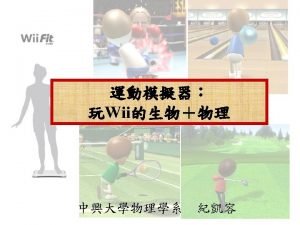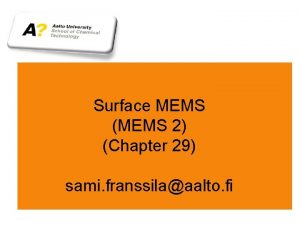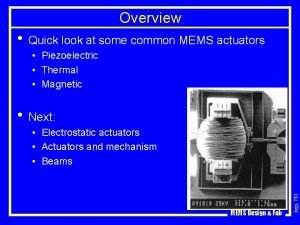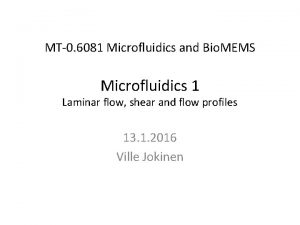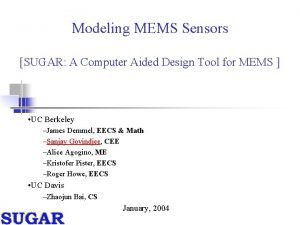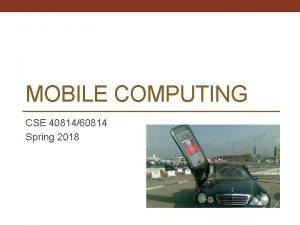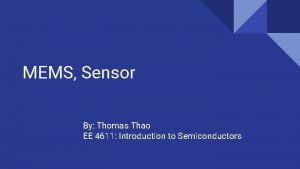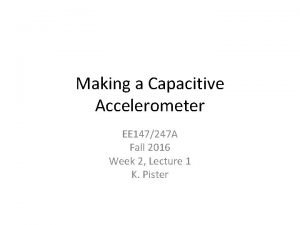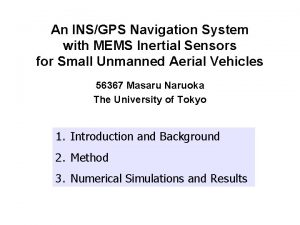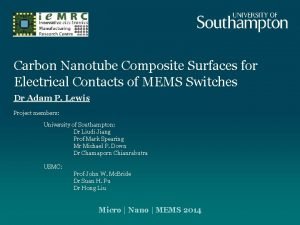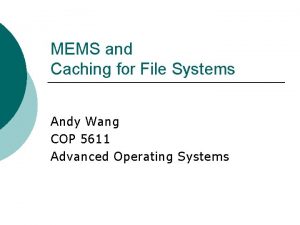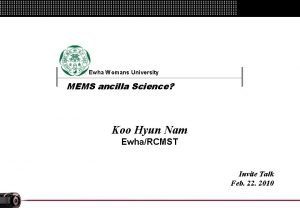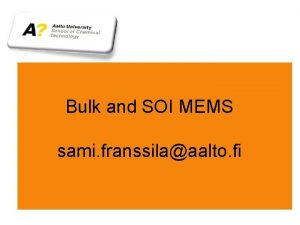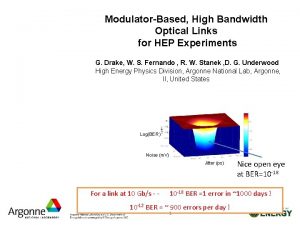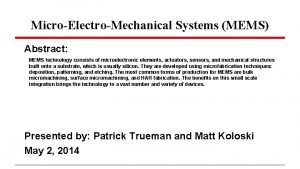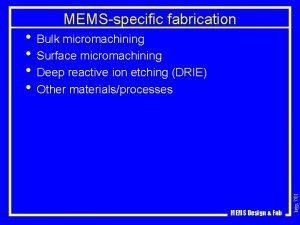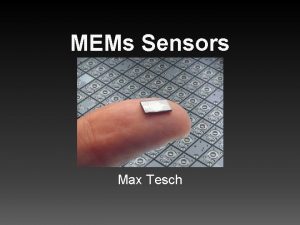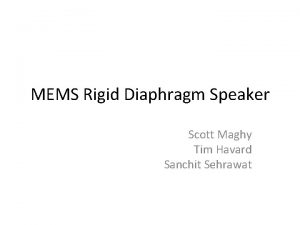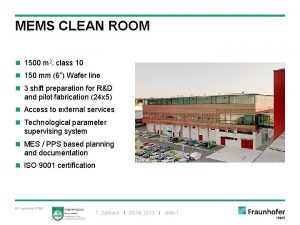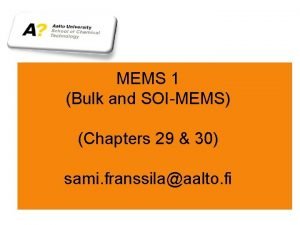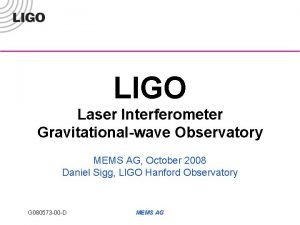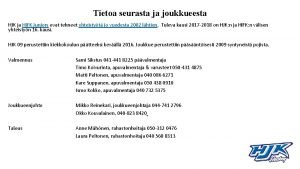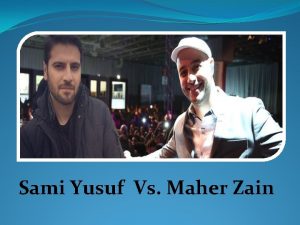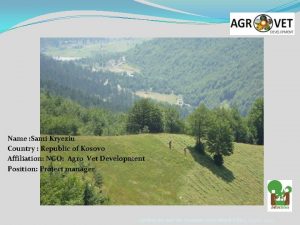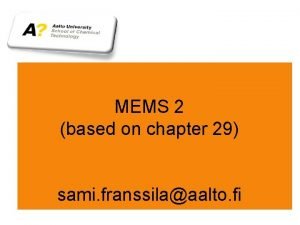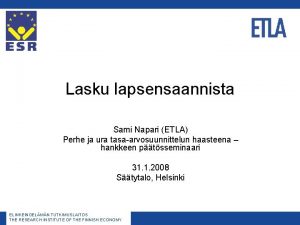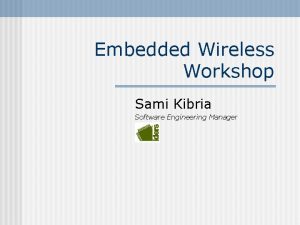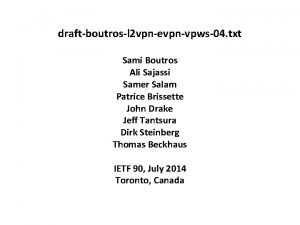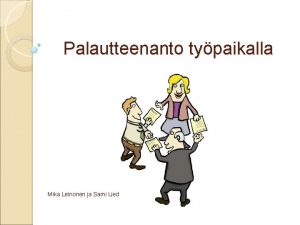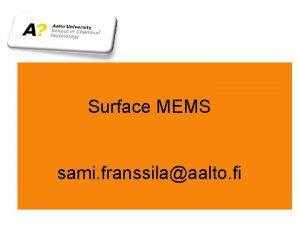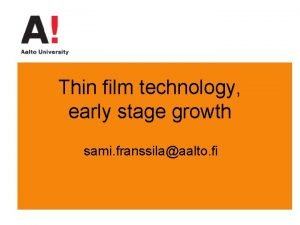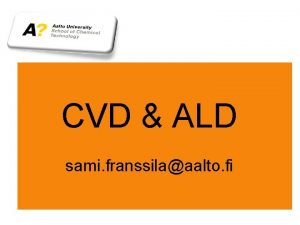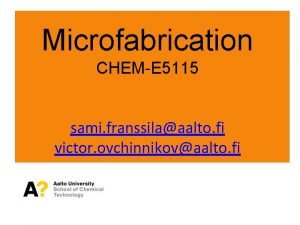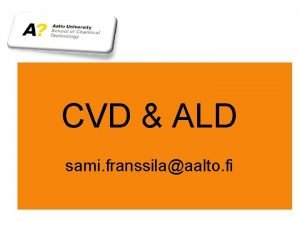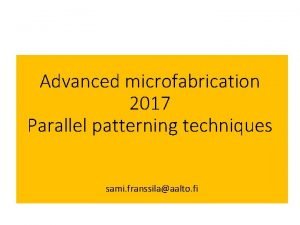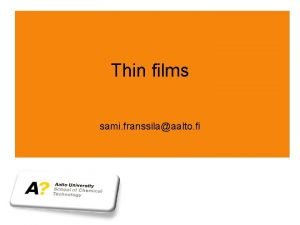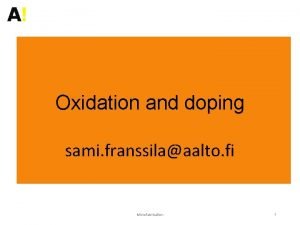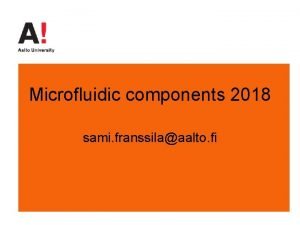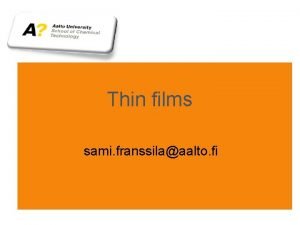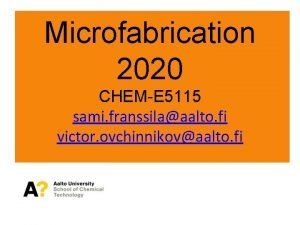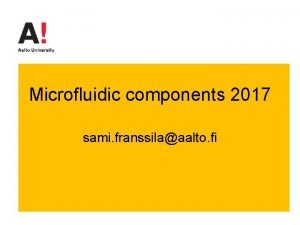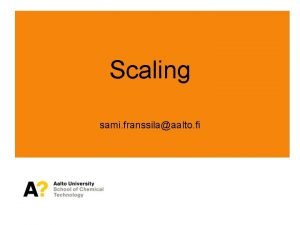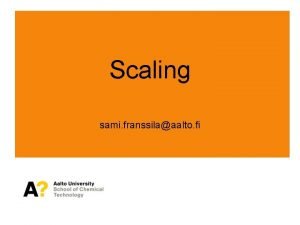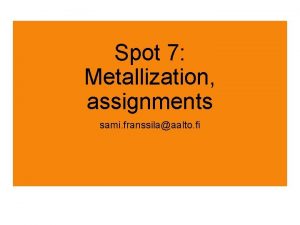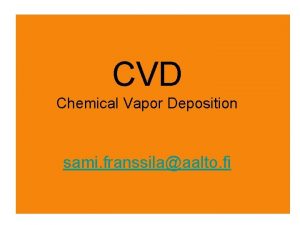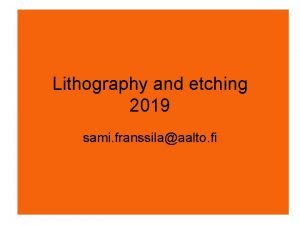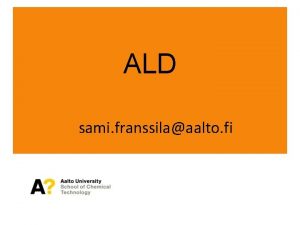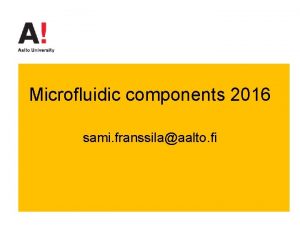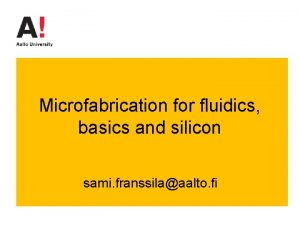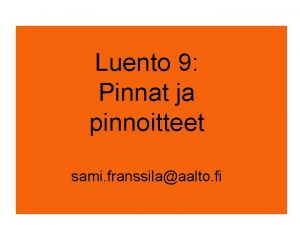Surface MEMS MEMS 2 Chapter 29 sami franssilaaalto


































- Slides: 34

Surface MEMS (MEMS 2) (Chapter 29) sami. franssila@aalto. fi

Surface MEMS

Generic surface MEMS structure Structural material (deposited later) Sacrificial material (deposited first) Substrate material Structural material has to be anchored to substrate somewhere Structural material stays Sacrificial material etched away Substrate material

Single mask process Two mask process Single mask process mask #1 Etch structural layer with resist mask #2 Etch sacrificial layer without resist Etch structural layer with resist mask Etch sacrificial layer without resist

Single mask vs. two mask cantilever Two mask process Single mask process mask #1 Etch structural layer with resist mask #2 Etch sacrificial layer without resist Etch structural layer with resist mask Etch sacrificial layer without resist

Material pairs & etchants Structural film Sacrificial etch(es) polysilicon nitride nickel aluminum gold copper Parylene SU-8 oxide Al Cu resist resist Cu HF, HF vapor HF Na. OH, H 3 PO 4 HCl oxygen plasma acetone, other solvents HCl

CVD oxides used as sacrificial layers

AFM tips: surface release Condition: Cr release etching must not attack Au or SU-8

Thermally excited resonator poly oxide 1. CVD oxide deposition 2. Poly deposition 3. Lithography piezores 4. I/I piezo doping & strip 5. Anneal I/I 6. Gold sputter depo 7. Litho for gold-heater 8. Gold etch & strip 9. Litho for poly 10. Poly etch & strip 11. Oxide isotropic etch 12. Rinse & dry

Surface micromachined microphone aluminum membrane Give step-by-step fabrication. oxide N+ diffusion <Si> Estimate dimensions. Note that profiles are Microsoft profiles, not microfabrication profiles.

Microphone 0. SSP silicon wafer, p-type 1. Thermal oxide 2. 1 st litho for diffusion 3. Etch oxide & strip resist 4. Clean 5. n-diffusion 6. Etch all oxide away 7. CVD oxide deposition 8. 2 nd litho: contact hole in oxide to n-diffusion 9. Etch oxide & strip resist 10. Aluminum sputtering 11. 3 rd litho: aluminum pattern 12. Etch aluminum & strip resist 13. Etch oxide, rinse & dry

Metal micromechanics (1)

Metal micromechanics (2)

Capacitive RF MEMS switch Top view Side view

Electroplated gold switch

Compressive stresses in film buckling Buckling depends on: 1) span on the structure: short beams do not buckle; 2) Stiffness of material: hard materials less prone than soft. 3) Stress level: high compressive stress easily leads to buckle Thermal Si. O 2 is always under compressive stress.

Tensile stress in film Tensile stress flat membrane CVD silicon nitride (1 GPa) ALD alumina (300 MPa) Desired stress state in most cases; however, too much tensile stress leads to cracking.

Released structural layers

Polysilicon • • • Deposited by CVD at 625 o. C true poly Can be deposited at 575 o. C amorphous Anneal after deposition: a-Si poly ! Typical thickness 1 -2 µm Doping a) during deposition b) after deposition

Polysilicon doping • Usually deposited undoped (practically insulator) • Doping after deposition – diffusion – implantation • • Annealing ~950 o. C, 1 h to activate dopants Annealing changes film stress (and grain size) Heavy doping ca. 500 µΩ-cm (cf. Al 3 µ Ω-cm ) Grain size ca. 200 -300 nm after anneal

Polysilicon stress anneal 580 o. C deposited film (a-Si) annealed differently, leading to different final stress

Marc Madou

Stiction ( sticking + friction) Capillary force of liquid exceeds mechanical strength of the released beam

Stiction prevention • Replace water by something that has lower surface tension, like isopropyl alcohol • Use stronger structures (H, T, I, U beams) • Change structural material • Redesign so that shorter beams needed • Use more elaborate drying • Use dry release no drying needed

Alternative drying

Stiffening beam by 3 D shaping

Stiction prevention: dry release Other dry releases: • Xe. F 2 dry etching of silicon • SF 6 isotropic plasma etching of silicon • HF-vapor etching of oxide

Ogawa, Masuda, Takagawa, Kimata: Polarization-selective uncooled infrared sensor with asymmetric twodimensional plasmonic absorber Opt. Eng. 53(10), 107110 Isotropic silicon etch

Perforation to release large area structures

Stiction prevention: dimples by three mask process

Types of MEMS Bulk MEMS: anisotropic wet or DRIE of bulk silicon SOI MEMS: DRIE or wet etching of SOI wafers Surface MEMS: thin films on top of a wafer Integrated MEMS: CMOS and MEMS on same chip

CMOS-MEMS: surface & bulk a a) surface MEMS by front side dry plasma release; b b) single crystal silicon MEMS by backside DRIE

CMOS-MEMS (2) If a fully processed CMOS wafer is used as a starting substrate for MEMS processing, what limitations are there ?

Surface MEMS
 Nintendo mems
Nintendo mems Mems stiction
Mems stiction Mems magnetic actuator
Mems magnetic actuator Mems microfluidics
Mems microfluidics Sugar mems
Sugar mems Mems gyroscope
Mems gyroscope Sensata technologies wikipedia
Sensata technologies wikipedia Mems accelerometer
Mems accelerometer Mems inertial navigation system
Mems inertial navigation system Mems cantilever beam
Mems cantilever beam Mems
Mems Is mems a female
Is mems a female Mems
Mems Mems mirror
Mems mirror Mems
Mems Mems
Mems Mems micromirror
Mems micromirror Max mems
Max mems Mems speaker
Mems speaker Mems clean room
Mems clean room Mems
Mems Mems ag
Mems ag Okko kouvalainen
Okko kouvalainen Sami yusuf son
Sami yusuf son Sami kryeziu
Sami kryeziu Sami vibration switch
Sami vibration switch Atahiyatu
Atahiyatu Sami napari
Sami napari Sami kibria
Sami kibria Ali sajassi
Ali sajassi Sami khuri
Sami khuri Sami people language
Sami people language Uva radiology tutorial
Uva radiology tutorial Igralec ramek
Igralec ramek Sami liedes
Sami liedes
